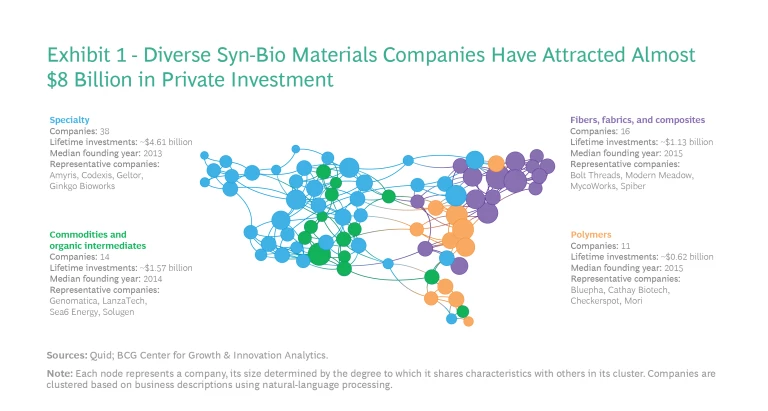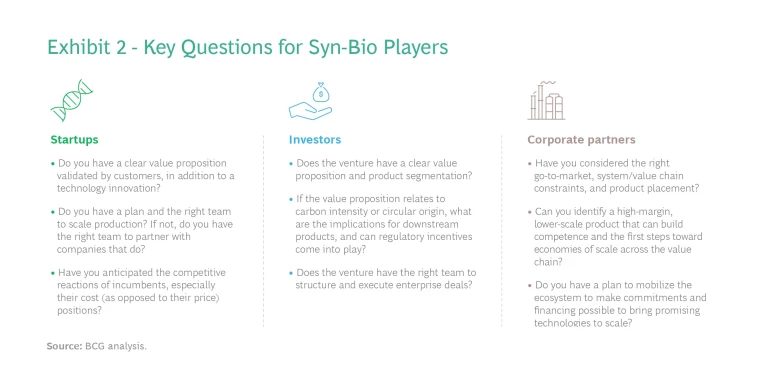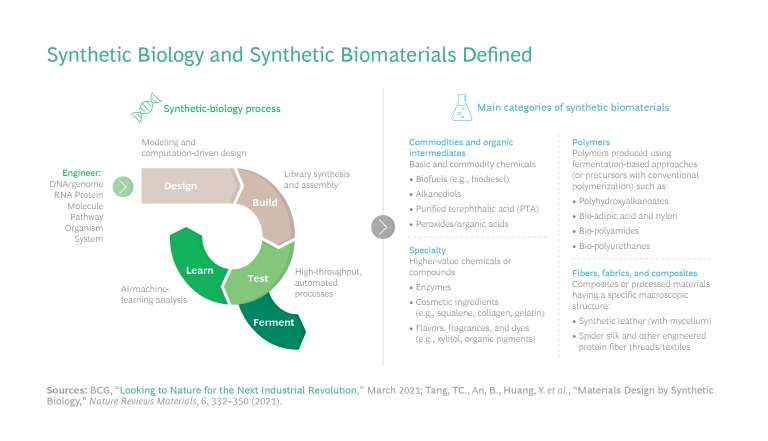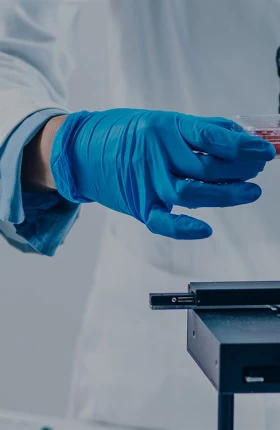Among the advanced technologies racing to solve big problems, synthetic biology stands out. Syn-bio, as it is known—the design and engineering of biological systems to create and improve processes and products—offers new ways of producing almost everything we consume, from flavors and fabrics to foods and fuels. We can thank syn-bio for the COVID-19 mRNA vaccines and the alternative proteins movement, among other innovations. And many see syn-bio materials, chemicals, and ingredients as high-potential opportunities to make lower-carbon, or even nature-positive, materials with new functionality.
But potential syn-bio investors—whether corporate, venture capital, or private equity —should be careful not to assess the opportunities through rose-colored lenses. While the potential and the investment to date are real, progress has been uneven. The health care and food sectors have seen many of the market successes so far and, for that reason, much of the investment. The chemical and materials industry has generated only a few commercial successes and plenty of tales of technology hubris and market woe.
Synthetic biology is a difficult technology to master and especially tough to scale. In materials, new players and products have long encountered the difficulties of penetrating highly efficient value chains, one reason that materials startups received only 4% of the $17 billion invested in syn-bio in 2021, according to a report from Built with Biology.
Chemical and materials startups and their backers need to find the meeting place of technology capability, market need, and cost in their industry or area of focus. By working toward the right success factors, entrepreneurs, investors, and corporate players can establish a firm commercial and financial footing that will enable synthetic biomaterials to deliver on their promise of innovative solutions and value.
Real Potential…
According to an analysis by BCG’s Henderson Institute, synthetic biology could disrupt industries that account for as much as 30% of global GDP by 2030 . (See “What Are Syn-Bio Materials?”) The timing and expected impact vary across industries, with materials and chemicals expected to see cost-based competition from syn-bio alternatives in the medium term. Still, the investment is already flowing.
What Are Syn-Bio Materials?
These organisms are typically fermented (bacteria and yeast, for example) but can also be grown (examples include mycelia or plant cells). Syn-bio materials span basic and commodity chemicals; specialty chemicals and compounds; polymers; and fibers, fabrics, and composites. They have applications in multiple industries, including, among others, packaging for consumer goods, grocery, and retail; textiles, apparel, and luxury goods; and beauty and cosmetics.
Two announcements in November 2022 point to how synthetic biomaterials can find viable markets for carbon-friendly products and attract interest and investment from both private funders and corporate partners. Solugen, a Houston, Texas-based synthetic-chemical company that specializes in making carbon-negative chemicals, raised more than $200 million in a Series D funding round that brought its total valuation to more than $2 billion. Skokie, Illinois-based LanzaTech, which seeks to transform waste carbon into useful materials such as fuels and fabrics, announced a joint venture with Japan’s Sumitomo Riko Company, a major rubber and resin producer, to reuse rubber, resin, and urethane waste in the manufacturing of synthetic rubber.

Our analysis shows that 79 syn-bio materials companies are currently focusing on applications from apparel to chemicals to cosmetics and have attracted almost $8 billion in private investment. (See Exhibit 1.) Both the number of funding events and the amounts have increased in recent years. Funding events jumped by almost 10% per year between 2018 and 2022, from 21 to 35, a strong indicator of rising activity. Specialty-chemical and ingredient manufacturers accounted for 42% of the investment events, with the remainder divided roughly evenly among fibers, fabrics and composites, commodity chemicals, and polymers. The amount of funding per year soared over the same period, from $330 million to $2.22 billion, in line with broader syn-bio investments.
A big reason for the rising investment is CO2 emissions. Eight global supply chains, including food, construction, fashion, electronics, and mobility (and the energy they consume), account for 50% of all emissions, with raw-materials extraction and refinement responsible for most of the CO2. Replacing extracted raw materials with bio-based alternatives would accelerate the current restructuring of global supply chains, have ripple effects on logistics, and potentially generate a substantial positive social impact.
…But a Tough Road to Realization
This has started to happen. Emerging materials and syn-bio platforms are being integrated into new manufacturing systems and offer the means to break through long-standing tradeoffs involving efficiency, scale, resilience, and sustainability . But existing value chains strongly encourage drop-in substitutions that are competitive on price and performance rather than incentivizing new use cases and functionality. This leads to a Catch-22 for syn-bio materials hopefuls: they need economies of scale to match conventional products on price but cannot get to scale with a more expensive bio-sourced product.
Consistent with deep-tech startups generally, syn-bio materials companies face a tough road. Even among those that have raised substantial funds, the failure rate is high, and for others, success is typically a long time in the making.
We identified 19 companies that attracted more than $100 million each in private investment. Four have since failed or been acquired. The performance of the few public companies has been uneven. Private companies (all but three are US based) range in age from 2 to 25 years, with 12 started in 2015 or earlier, of which 6 were born before 2010—another indication that evaluating the potential of advanced technologies is tough, and finding a winning combination of market need and emerging technology that realizes the potential is harder still.
The considerable list of specific challenges facing syn-bio materials companies includes the following issues.
Product–Market Mismatches. Targeting the right segment or subsegment with a product that accurately addresses its needs is far from simple, and materials entrepreneurs often overestimate the ease with which a new material can be integrated into a product or process. True drop-in solutions are rare because performance requirements along the value chain tend to be opaque to outsiders and difficult to test for, often resulting in failure or disappointment. As we have noted before with respect to the apparel industry , bio-sourced materials such as PHA, spider silk, and chitosan have failed to make substantial inroads because of the lack of incentives for both mills and integrators to take on the risks of new materials that are incompatible with their existing processing equipment.
Syn-bio materials hopefuls need economies of scale to match conventional products on price but cannot get to scale with a more expensive bio-sourced product.
Economics. Even if the product and market fit are compelling, startups still need to get the economics right, since price and risk sensitivity can have a determining impact on the uptake of new products. This is often a question of the new product’s value to the end user or OEM, but it also can pertain to all the companies doing processing or conversions in between. Many large markets, such as food packaging, are extremely price sensitive, and companies are unwilling or unable to absorb the higher costs or other risks of new materials. For example, a textiles startup with a new material that had good long-term potential to reduce carbon emissions and cost could not overcome the near-term market reality of the conventional alternative’s lower production costs (and, therefore, lower price).
In our experience, some manufacturers in carbon-sensitive industries are willing to pay more—sometimes 20% to 30% more—if a product helps meet identified needs, such as reducing scope 3 emissions, or otherwise helps value chain participants meet their climate commitments. But too often, syn-bio companies bank on charging substantial green premiums (as much as 200%) to make the economics work, without adequate consideration of how those costs will affect others downstream. Our research indicates that while up to 80% of consumers say they think about sustainability in their day-to-day purchases, only 1% to 7% (depending on the sector) report that they are paying a premium for sustainable products and services. Even in cases where consumers may be willing to pay extra, it can be hard for them to appreciate syn-bio’s contribution to the overall product.
Technology Push Rather Than Market Pull. Even large and established companies often convince themselves that the technological superiority of a new product or process will win out. Markets (and commodity pricing cycles) determine otherwise. Historically, many innovations in materials involving polymers, composites, and nanomaterials have failed to create new markets despite the unique capabilities they provide. Similarly, merely being “bio-based” (or having a “syn-bio platform”) is not sufficient. One failed venture, for example, built a plant to produce 50,000 tons a year of its product but could not sell 500 tons in the first year of operations. For functional materials, in particular, large customers often have qualification cycles for new products that are more demanding and time-consuming than syn-bio innovators can tolerate.
Scaling. Chemical and materials startups face a double-barreled challenge: they need to ramp up sales to bring costs down, but many of the applications they target are well served by conventional products produced at massive scale with commensurate economies. Even technologies that demonstrate recognized promise encounter difficulties. Multiple ventures have struggled to obtain capital or resolve scale-up issues. Typical contract development and manufacturing organizations focus primarily on health care applications and lack expertise with strains and purification processes for biomaterials, which creates additional risk. One startup took on heavy debt to build its first plant but then fell victim to persistently low energy and raw-material costs that advantaged conventionally produced products.
Lack of Business Model Clarity. New materials can have many potential markets, and startups often see multiple opportunities. This can lead to a lack of clarity in product design and business model. Key questions to ask are, Is the product an ingredient or a finished good? A molecule or a semifinished product? And does the product target suppliers to others or end users?
Subscribe to our Digital, Technology, and Data E-Alert.
When syn-bio founders struggle with one or more of these questions, they often seek to change the business model (from licensing to service to direct-to-consumer, for example) instead of prioritizing the underlying value proposition. These changes in direction lead to confusion and distraction among the management team when it should be focused on critical issues such as commercialization and scaling.
Focusing on the Right Success Factors
The journey from lab to market for any syn-bio material is long, with plenty of opportunities for missteps or wrong turns. Entrepreneurs need to apply a strict market focus from the get-go. Investors and corporate partners can help guide them through the middle and later phases of startup so long as everyone agrees to the same set of success factors.
Market. Start with the market problem to be solved rather than the technology to be developed. This analysis should include an assessment of the importance and extent of unmet needs and the likely timeline for initiating and then effecting a market shift from current products or processes to new solutions. Identify the policy and regulatory changes that could move goalposts or reshape the playing field.
Bear in mind that to contribute to environmental sustainability, solutions must be financially sound. The hard truth is that while “bio-better” is a compelling vision, there are few products on the market today that have reached a scale that truly decelerates climate change. Many of the documented failures to date fell victim to unexpectedly low oil and commodity prices that undercut their financial viability before they were able to achieve adequate economies of scale.
Adoption. Because syn-bio product yields tend to be low, financially viable solutions are much more likely to take the form of high-value products or functional substitutes in high-value markets rather than drop-in replacements for bulk commodities. There have been a number of niche syn-bio successes in flavor and fragrance compounds, for example, where incumbent molecules are expensive or supplies are limited. In addition, companies looking to make an impact will design solutions that are compatible with current systems or value chains rather than requiring a re-engineering of existing equipment or processes. For example, Bolt Threads designed Mylo, a sustainable alternative to leather made from mycelia (the branched filaments that make up a typical fungus), to be easily used in conventional production processes by apparel customers, such as Adidas and Stella McCartney.
Because syn-bio product yields tend to be low, financially viable solutions are much more likely to take the form of high-value products or functional substitutes in high-value markets.
New solutions can sometimes prove themselves by focusing on a tight market segment or subsegment. Identifying an achievable entry point can help focus and scale the organization appropriately.
Support. Startups and their backers cannot expect customers to revamp products or production processes to accommodate a new input (especially if that input is essentially a new molecule). Application support is key. Suppliers need to understand their customers’ purchasing processes and, in many cases, their manufacturing critical-to-quality criteria. They may need to perform in-use testing for potential customers. Corporate partners that have relevant industry knowledge and experience can be especially helpful in this regard. Startups should also investigate adding industry experts and practitioners to their development and sales teams in target markets.
Scale. Plenty of startups dream big, but how many plan for the day when they need to scale up to realize those dreams? For materials companies, the problem of manufacturing the fruits of their labors at scale looms large, and it’s never too early to plan for that first pilot plant, including a budget and a scheme for accessing the necessary engineering and project management talent. Moving from lab to large reactors, and from models to production organisms frequently leads to unexpected issues in production efficiency and concentration of the final product or titer. Accessing pilot scale facilities and using cell-free prototyping can help reduce risk. Some young companies have creatively recycled existing production plants to reach scale quickly. Genomatica, a California-based biotechnology company, produced 5 million pounds of renewable 1,4-Butanediol (BDO) in five weeks at a DuPont Tate & Lyle plant in Tennessee in 2012. Two major European chemical companies have since licensed its process.
Cost. The cost in use of a substitute material needs to be competitive, and the new material should not require other substitutions or changes to the supply chain that add cost or create bottlenecks. Syn-bio companies need to understand how their product contributes to the total cost of their customers’ products, both absolutely and compared with competing materials.
Amyris, for example, has had success with its sugarcane substitute for squalene (an important vaccine adjuvant) because squalene is a natural ingredient harvested from shark livers. Amyris offers high quality, sustainability, a steady supply, and a stable price, the latter being an important part of its overall value proposition.
Successful companies target specific industries and needs. A cosmetics maker may be willing to pay more for dyes or pigments produced using synthetic biology given the high price point of its products. In contrast, a textile company would not be likely to use such substitutes in its mass-market products, for which price is a major competitive consideration; however, the company might consider using them sparingly in higher-priced niche products marketed to certain consumer segments.
Value Proposition. Above all, new players need to understand their value proposition—one that has been validated by customer feedback—and stick to it religiously. Does the product offer superior performance? Lower carbon intensity? Lower cost? Steady supply? Is its circular origin a selling point? Amyris, as noted above, emphasizes its squalene substitute’s quality, sustainability, supply, and price. Genomatica stresses the performance, sustainability, and “carbon reduction and competitive economics” of the products in its portfolio, which include alternatives to nylon and palm oil, among other inputs, that can be used in a wide range of consumer and industrial goods, such as shoes, car components, electronics, and cleaning products. In these cases, the companies’ value propositions also align with market and customer needs.

There are ample early demonstrations of the impact that syn-bio materials can have in multiple B2B and B2C sectors, including fashion, fast-moving consumer goods, and specialty chemicals. Funding is on the rise, and sustainability concerns and net-zero pledges are pushing the technologies forward. That said, the roadmap to game-changing scale and value is still being drawn, and startups, investors, and corporate partners all need to focus on moving solutions forward. (See Exhibit 2.)
Startups need to put as much energy and effort into the commercial aspects of their businesses as they devote to the technological. Investors must understand the long timelines involved in both new technologies and materials substitutions and replacements. They should also be prepared to offer more than just funding to portfolio companies. Corporate partners, which often have the knowledge, experience, and market access that startups lack, will play a critical role—so long as they, too, have their own clearly developed objectives and expectations. Big winners will keep their eyes wide open and focus on the factors that promote commercial as well as technological progress.










